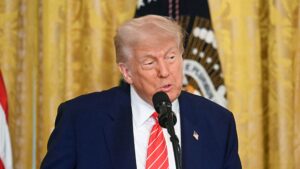Trump’s Bold Move to Lower Drug Prices: What You Need to Know
In a significant turn of events, President Donald Trump is set to reinvigorate a controversial strategy aimed at slashing drug costs by aligning U.S. government prices with lower rates found internationally. This policy, known as the "most favored nation" initiative, will be formalized through an executive order on Monday, as confirmed by White House officials.
The Motivation Behind the Policy
"The American people have been shouldering an unfair burden for too long," one official remarked, highlighting the perceived inequity of foreign nations benefiting from lower pharmaceutical costs while U.S. patients endure higher prices. The administration’s clear goal is to bring down drug prices, an issue that resonates deeply with American consumers.
Market Reactions: Pharmaceutical Stocks in Disarray
In anticipation of the announcement, shares of major pharmaceutical companies plummeted in premarket trading. Eli Lilly saw a drop of over 5%, while industry giants Pfizer, Merck, and Johnson & Johnson followed suit, each dipping more than 2%. This reaction underscores the market’s apprehension about the ramifications of the policy on future profitability and innovation.
Pending Details: Which Drugs Will Be Affected?
While the specifics of the medications encompassed by the executive order remain undisclosed, officials indicated that the scope would be broader than a previous policy targeting only Medicare Part B drugs. Expect particular emphasis on high-expenditure medications with the most substantial disparities in pricing—GLP-1 drugs, often used for diabetes and weight management, are likely candidates.
The Economics of Drug Pricing
Despite the ambitious aims of the "most favored nation" policy, its effectiveness is under scrutiny. Experts from USC caution that such measures might not address the fundamental economic factors of the global pharmaceutical market, where U.S. sales represent about 70% of profits. The potential fallout? Drug manufacturers may retreat from international markets, leaving American consumers with stagnant prices and stunted innovation.
Navigating the Political Landscape
This initiative also brings a host of challenges. The pharmaceutical industry, represented by PhRMA, estimates that Trump’s proposals could cost drugmakers an astounding $1 trillion over the next decade. The precedent of legal challenges looms large, as similar policies faced obstruction in the past, and the possibility of renewed legal battles is a stark reality.
Future Outlook: Implications for Patients and Manufacturers
While the executive order opens the door for lower drug prices, it poses intricate questions for companies regarding their pricing models and R&D investments. Trump’s administration remains committed to monitoring drug pricing mechanisms globally and penalizing any unfair negotiations. In a coming wave of negotiations, Health and Human Services (HHS) Secretary Robert F. Kennedy Jr. will also set immediate targets for price reductions, marking a decisive pivot in drug pricing policy.
Moreover, the administration’s intent to expand drug imports from developed nations signals a multifaceted approach to tackling high pharmaceutical costs. The Department of Justice and the Federal Trade Commission will pursue actions against anti-competitive practices locally, further shaping the landscape.
As we digest these developments, the narrative of drug pricing in America gains new intensity. Trump’s efforts prompt concerns over immediate impacts yet align closely with the pressing needs of patients desperate for affordable medications. Over 75% of American adults have previously indicated that the costs of medications are prohibitively high.
Conclusion: Why This Matters
As the Extreme Investor Network closely monitors these changes, the implications of Trump’s executive order resonate with both patients and investors. With stakes this high, will this policy change the drug pricing landscape, or will it lead to more extensive challenges for both consumers and the pharmaceutical industry?
Stay tuned as we continue to unpack the unfolding implications of this policy while delivering insightful analyses to empower your investment decisions.

